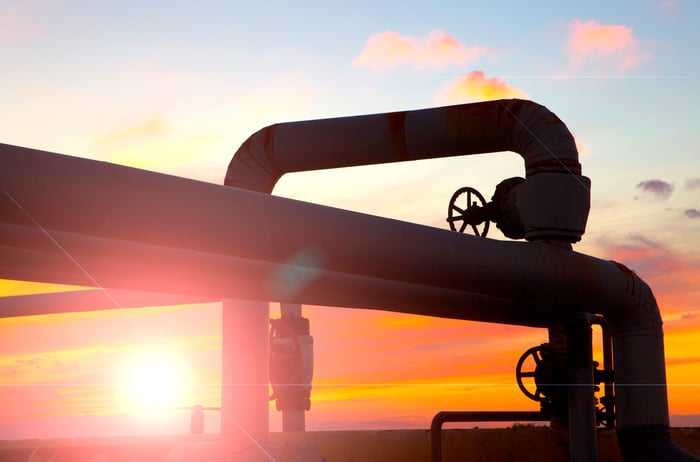Energy Transfer LP (ET -0.19%) delivered its first earnings report since the former Energy Transfer Equity merged with Energy Transfer Partners to create one simplified entity. The newly combined company didn't disappoint, as recently completed pipelines helped drive earnings and cash flow to record levels in the third quarter.
Drilling down into the results
|
Metric |
Q3 2018 |
Q3 2017 |
Year-Over-Year Change |
|---|---|---|---|
|
Adjusted EBITDA |
$2.58 billion |
$1.95 billion |
32.2% |
|
Distributable cash flow (DCF) |
$1.38 billion |
$1.09 billion |
27.2% |
|
DCF per unit |
$0.53 |
$0.43 |
23.3% |
|
Distribution coverage ratio |
1.73 times |
1.59 times |
8.8% |
Data source: Energy Transfer LP.
Energy Transfer expanded earnings more than 30%, while cash flow grew by an equally impressive rate thanks to nearly across-the-board growth in the company's operating segments:

Data source: Energy Transfer LP. Chart by author.
The crude oil transportation business led the way, with earnings rocketing more than 60% year over year. The primary driver was higher volumes flowing through the company's oil pipelines, including the Bakken Pipeline, which just started up last year, and its system in the Permian where the company also benefited from placing the Permian Express 3 pipeline into service.
Earnings on interstate gas pipelines surged more than 50%, in large part because of the Rover Pipeline, which started up this year. Meanwhile, profits in intrastate transportation, midstream, and natural gas liquids (NGLs) and refined products transportation also increased from the year-ago period because of higher volumes and margins, thanks to an improvement in commodity prices as well as recently completed expansion projects.
The lone laggard was the "all other" segment where earnings slumped. However, that's because the company sold some of its stake in Sunoco LP and its compression business to USA Compression Partners, while its interest in refiner Philadelphia Energy Solutions fell as part of that company's bankruptcy reorganization.

Image source: Getty Images.
A look at what's ahead
Now that Energy Transfer's consolidation transaction is in the rearview mirror, the company's focus will be to continue expanding its energy infrastructure empire. The company made excellent progress on that front in the past quarter by finishing up the final sections of Rover, which are now in service, while also continuing construction on several other expansions that should start up over the next couple of years.
On top of that, the company added new projects to its backlog. The most notable is the Permian Gulf Coast Pipeline, a 600-mile oil pipeline that it's developing with several partners. The company expects that project to be operational by the middle of 2020.
The company also recently announced that it will build a seventh NGL fractionation facility in Mont Belvieu, Texas, which will separate raw NGLs into propane, butane, and ethane. The company expects that project to start up in the first quarter of 2020. Energy Transfer just finished its fifth fractionator in July -- which is already running at full capacity -- and is expected to complete its sixth in the first quarter of next year, putting it ahead of schedule.
Energy Transfer also said it plans to expand its Lone Star Express Pipeline -- which transports NGLs from the Permian Basin to Mont Belvieu -- by adding 352 miles of new pipeline to extend the system. The company expects this new pipeline to enter service by the end of 2020.
These recent project additions, when combined with the rest of the backlog, position Energy Transfer to continue growing its earnings and cash flow at a brisk pace in the coming years.
Stomping on the gas
Energy Transfer's expansion efforts are continuing to pay big dividends. The company's high-yielding payout is therefore becoming increasingly more sustainable, since its coverage ratio is expanding alongside cash flow, which is enabling it to retain more cash to fund its growing backlog of expansion projects. That combination of growth and income could give Energy Transfer the fuel to generate substantial total returns for its investors in the coming years.





